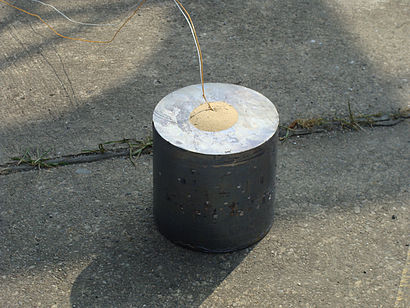Trauzl lead block test: Difference between revisions
m Bot: Migrating 8 interwiki links, now provided by Wikidata on d:q883527 (Report Errors) |
|||
| Line 3: | Line 3: | ||
The test is performed by loading a 10-gram foil-wrapped sample of the explosive into a hole drilled into a [[lead]] block with specific dimensions. The hole is then topped up with sand, and the sample is detonated electrically. After detonation, the volume increase of the cavity is measured. The result, given in cm<sup>3</sup>, is called the '''Trauzl number''' of the explosive. |
The test is performed by loading a 10-gram foil-wrapped sample of the explosive into a hole drilled into a [[lead]] block with specific dimensions. The hole is then topped up with sand, and the sample is detonated electrically. After detonation, the volume increase of the cavity is measured. The result, given in cm<sup>3</sup>, is called the '''Trauzl number''' of the explosive. |
||
The Trauzl test is not useful for some modern higher-powered explosives as their power often cracks or otherwise ruptures the lead block, leaving no hole to measure.<ref name="Lead-Block Test for Explosives">{{cite journal|last=Lepper|first=Bessie|coauthors=F. Everett Reed, William E. Gordon|title=Lead-Block Test for Explosives|journal=Industrial and Engineering Chemistry| |
The Trauzl test is not useful for some modern higher-powered explosives as their power often cracks or otherwise ruptures the lead block, leaving no hole to measure.<ref name="Lead-Block Test for Explosives">{{cite journal|last=Lepper|first=Bessie|coauthors=F. Everett Reed, William E. Gordon|title=Lead-Block Test for Explosives|journal=Industrial and Engineering Chemistry|date=September 1955|volume=47|issue=9|pages=1794–1800|doi=10.1021/ie50549a028|url=http://pubs.acs.org/doi/abs/10.1021/ie50549a028|accessdate=08 Aug 2011}}</ref> |
||
A variant of the test uses an [[aluminium]] block in an effort to reduce participants' exposure to [[Lead poisoning|lead-related]] [[Dangerous goods|hazards]]. |
A variant of the test uses an [[aluminium]] block in an effort to reduce participants' exposure to [[Lead poisoning|lead-related]] [[Dangerous goods|hazards]]. |
||
Revision as of 01:51, 31 January 2014
The Trauzl lead block test, also called the Trauzl test or just Trauzl, is a test used to measure the strength of explosive materials. It was developed by Isidor Trauzl in 1885.
The test is performed by loading a 10-gram foil-wrapped sample of the explosive into a hole drilled into a lead block with specific dimensions. The hole is then topped up with sand, and the sample is detonated electrically. After detonation, the volume increase of the cavity is measured. The result, given in cm3, is called the Trauzl number of the explosive.
The Trauzl test is not useful for some modern higher-powered explosives as their power often cracks or otherwise ruptures the lead block, leaving no hole to measure.[1]
A variant of the test uses an aluminium block in an effort to reduce participants' exposure to lead-related hazards.
Examples

Explosive power of chemical explosives by Trauzl number:
| Explosive | Trauzl rating (cm³/g) |
|---|---|
| Acetone peroxide | 25-33 |
| RDX (C4/Hexogen) | 45 |
| HMTD | 33 |
| HMX (octogen) | 48 |
| Nitroglycerin | 52 |
| Pentaerythritol tetranitrate | 52 |
| Trinitrotoluene (TNT) | 30 |
Notes
- ^ Lepper, Bessie (September 1955). "Lead-Block Test for Explosives". Industrial and Engineering Chemistry. 47 (9): 1794–1800. doi:10.1021/ie50549a028. Retrieved 08 Aug 2011.
{{cite journal}}: Check date values in:|accessdate=(help); Unknown parameter|coauthors=ignored (|author=suggested) (help)
